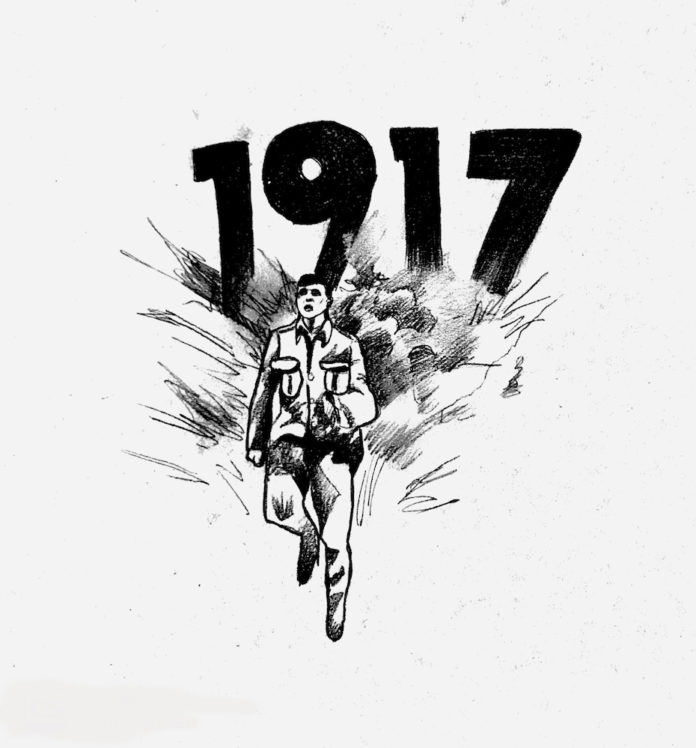As the final film to slip into contention for the Academy Award for Best Picture at this year’s Oscars, Sam Mendes’ “1917” provided the Motion Picture Academy with a safe potential selection. The British director’s World War I drama is enjoying a successful box office run after being released Dec. 25. It seems the moviegoing public is excited to see Mendes reach back to a historical conflict rarely depicted in recent major war films. The movie’s basic appeal comes from a modest and linear plot that presents ordinary soldiers tasked with a heroic deed. The stiff numerical title carries across seriousness and a sense of realism. There is something frustratingly unimaginative about this naming, but it is surprisingly on-brand for a film with a narrative that wholeheartedly resists personal interpretation.
No one would mistake “1917” for a documentary. However, the film’s straightforward arc and tone consume every part of its cinematic experience. Mendes uses long takes unrelentingly. He is completely committed to the effect of a single continuous take. More often then not, the long take puts the audience directly behind the movement on-screen. Consequently, we are forced to follow the story from a detached position.
From the film’s first moment, it chisels in on the patriotic and personal dilemma that calls British soldiers Tom Blake and Will Schofield into war. General Erinmore informs the startled young men of a nearby regiment’s potentially disastrous strategic error. As a result of British miscommunication, the German army is only hours away from luring 1,600 soldiers into a deadly trap. Blake’s brother is among them, and his life now hangs in the balance. The two friends must travel across the land to stop the regiment from advancing. For the next two hours, it is as if the whole world is reduced to the completion of this task. Mendes is hardly interested in pursuing anything outside of this spectacle.
As the long take wears on, “1917” begins to feel like a Call of Duty campaign mode cut scene you can’t skip through. The sparse characters we meet along the way are reminiscent of those who hold instructions or trigger sudden actions in a video game, and each location is given a distinct atmosphere that resembles the separate stages of levels. The horrors of war take on a monstrous quality that makes Blake and Schofield’s journey feel like creeping through a haunted house. When they inch through an abandoned German base, the audience clenches for a jump-scare. It is a bit cheap for Mendes to fall back on this sort of bait-and-reveal tactic to muster up key dramatic moments. If the film was not so wedded to its long-take stunt, perhaps these sequences would better rhyme together to convey Schofield’s emotional and physical endurance. Instead, the script is padded with checkpoints that rush to the finish line without engaging memory.
It is difficult to truly impress the weight of war on an audience with such familiar and impersonal cliches. Still, the pseudo-immersive gimmick behind “1917” makes it one of the first major films to visualize war in an obvious effort to correspond with the pop culture phenomenon of military video games. Mendes wants the immersion of the gaming medium without the audience interaction that comes with it. The slick digitization of each frame stunts the film’s emotional potential.
About halfway through the mission a German plane comes crashing into their path. Up until this point, the minimal character development presents Blake as singularly focused and determined. When he is predictably killed for attempting to treat the wounded enemy pilot, it is a sacrifice designed to pull the audiencecloser to two men viewers barely know. Their bravery is apparent, but the film repeats this point as if that is all there is to being both a soldier and a human being. Even as he ventures forward alone, Schofield’s inner life is reduced to pure obligation and responsibility. These are highly respectable values, but the lack of personality drains “1917” of the necessary character complications that make a story compelling.
The true protagonist in this race against the clock is Mendes’ camera. He is fascinated by what it can do and the way it can make choreographed movements appear natural. “1917” reaches for a technical thrill while copping out on the opportunity to create an artistic thrill. Eventually, the put-on overtakes the subject. There is no clear point of view regarding the decision to enter into war. Nothing in this film shows us what either side is fighting for beyond the chance to survive. The enemy is colored in grey as simply a bland oppositional force. If “1917” was awarded Best Picture, it may have become historically significant. However, it lost to Bong Joon-ho’s “Parasite,” and the film is destined to never be thought of again.
![]()



































